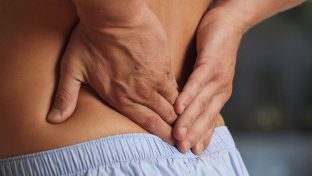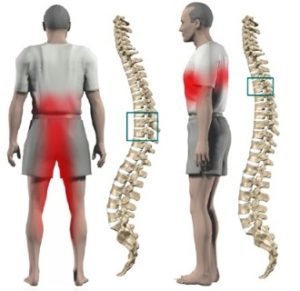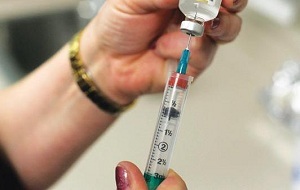Osteochondrosis of the spine, which has different symptoms and treatment, is one of the most common pathologies of the musculoskeletal system.
This condition is characterized by the development of degenerative-dystrophic changes in the intervertebral discs, which over time spread to the ligaments of the lumbosacral spine and bone tissue. An acute process, in the absence of therapy, inevitably becomes a chronic process.
Degenerative disease can disable a healthy person.
Degrees of lumbar osteochondrosis
Classify 4 degrees of osteochondrosis of the lumbosacral region. The scheme of development of the disease is as follows:
First degree.Inside the annulus fibrosus, lesions form in the form of cracks that cause irritation that penetrates the contents of the pulposus nucleus. This is the initial stage of osteochondrosis. Deformation of the intervertebral discs manifests itself with difficulty and causes reflex pain with sudden movements and heavy lifting. Unpleasant sensations in the spine can be mild and obvious:

- lumbodynia - local, persistent pain in the lower back;
- lumbago - "lumbago" with sudden pain in the lower back.
Second degree.Destructive processes in Anulus fibrosis continue. The distance from one vertebra to another is reduced and causes the nerve fibers to constrict. There is discomfort in the lower third of the back that turns into a feeling of pain.
Third degree.During this period, the final destruction of the ring fibrosis occurs by extrusion of the nuclear pulp. Vessels and nerve endings are compressed by intervertebral discs. An intervertebral hernia forms. The spine is curved:
- lordosis - arc deformity of the lumbar spine, forward bulge of the spine;
- kyphosis - the opposite position of the lordosis when the arc is formed in the external direction;
- scoliosis - a pathological curvature of the lumbar spine to the right or left.
extremeOsteochondrosis is considered the most severe and dangerous. In this case, the spine is already deformed, normal physical activity is lost. X-rays show bone growth in the spine - the body's reaction. The pain may not last long, but that doesn't mean it has improved. People suffering from stage 4 of sacro-lumbar osteochondrosis often become disabled. The reason is that the process is complicated at this stage.
Causes of lumbar osteochondrosis
Causes of lumbar osteochondrosis include:
- Proportional load on the spine.Man is an upright creature, so the load on the spine is considered normal when standing. Must move, bend and not bend while performing various movements. The musculoskeletal system is in a state of long-term tension to keep the body in any position. In the sitting position, the load on the spine increases and is minimal when lying on the back. When a person is in a position for a long time, the lumbar and sacral parts are overloaded and the muscles do not stop, before them there is a feeling of discomfort, then pain. This deforming factor creates the preconditions for the development of lumbar osteochondrosis.
- Sedentary lifestyle.Contributes to the development of various pathologies, including those that affect the spinal structures. Prolonged sitting leads to deformation of cartilage tissue and a decrease in muscle tone, leading to the development of osteochondrosis of the spine.
- Excessive physical force.Neither lack of strenuous physical activity nor excess is good for the musculoskeletal system. Long, hard work, especially when lifting and carrying weights, causes the back muscles to become very tense and causes vertebral hernias to form.
- Posture disorders.Deformation of the discs between the vertebrae can be caused by improper walking. The reason is the unequal load on the spine. Intervertebral discs lose their elasticity and mobility, and therefore are more likely to be damaged. Older and older people suffer from similar problems more than others.
- Bone defects, hereditary pathologies, trauma and infectious lesions.Osteochondrosis is often the result of congenital musculoskeletal disorders. For example, when the cartilage tissues of the body are naturally fragile. In addition, as in osteomyelitis and tuberculosis, spinal pathologies develop after traumatic injuries and infectious processes.
- Straight legs.Signs of a "special" foot are the absence of hollows and hanging arches. People with this condition often have spinal problems. This is due to the increased load on the intervertebral discs during walking. They are exposed to increased physical stress during lifelong movement, so they wear out quickly
- Obesity.Excess weight is a problem for the body and an additional burden. All organs and systems suffer, including the spine.
- Pathological processes.Dysfunction of various structures can adversely affect the condition of the musculoskeletal system. Thus, the factors that cause lumbar osteochondrosis are endocrine diseases, cardiovascular problems and digestive system dysfunction.
- Wrong lifestyle.Many people do not pay enough attention to simple and important things such as physical activity, balanced diet and normal sleep. An organism that has been under stress for a long time becomes weak and sensitive. Other pathologies that can occur in such a "fertile" soil include osteochondrosis of the spine.
Symptoms of lumbar osteochondrosis

Pathological changes in the lower back are manifested by severe symptoms;
- Back paingives the clearest "signal" of the development of lumbar osteochondrosis. The compression of the nerve endings of the spine speaks of the presence of "radical syndrome" when it causes pain in the lower back. The person becomes tired and nervous. Over time, simple and routine activities become a major problem due to back pain. If an intervertebral hernia develops in the lumbar region, the pain spreads to the lower leg, thigh and back of the leg. Over time, it becomes more difficult to sit and walk. Unpleasant feelings do not leave even when stretched. Temporary relief may vary with periods of exacerbation. ;
- dysfunction of the genitourinary system.These are pains in the kidneys, often manifested by the desire to urinate. Deformation of the intervertebral discs causes the lumbar spine to move relative to the sacrum. This affects the functioning of the internal reproductive organs in women and causes potential problems in men;
- Decreased sensitivity of the legs in the foot area.It can be either partial or absolute. At the same time, the reflexes of this part of the body are weakened. Progressive pathology leads to complete loss of sensitivity in the lower extremities;
- gait disorders.With osteochondrosis, low back pain causes a person to deviate in the opposite direction from where the nerve fibers are compressed while walking. The situation does not allow to go long distances. A lame person is forced to stop from time to time waiting for a painkiller. Timely medical care can save a person from disability.
Treatment of lumbar osteochondrosis
Many people wonder if osteochondrosis of the spine is treated and how it occurs. Therapeutic tactics are prescribed at the time of diagnosis and diagnosis.
There are various methods used to treat lumbar osteochondrosis. To treat a disease or to alleviate a person's condition as much as possible, it is important and advisable to use one of them, the doctor determines.
Someone treats themselves at home only with folk remedies, forgetting that they can be used only with the approval of a medical specialist and only as part of a complex therapy.
Medication for osteochondrosis
Drug treatment involves the use of:
- tablet forms;
- injection solutions; Preparations for external use - ointments and gels.
Medications are prescribed to relieve inflammation and lower back pain. Can be used at home.

These could be:
- analgesics;
- non-steroidal anti-inflammatory drugs;
- drugs for muscle spasms (muscle relaxants);
- means to restore cartilage tissue (chondroprotectors);
- corticosteroids (hormone-containing drugs that work to relieve pain and inflammation)
- vitamins.
The course of treatment is prescribed by a doctor, who sometimes prescribes a pill or potion to calm the nervous system as an additional treatment.
Physiotherapy for lumbar osteochondrosis
Physiotherapy is another common method of relieving the symptoms of osteochondrosis of the spine. Increases metabolic and restorative processes by acting on the spine and lumbar region.
Most Posted:
- magnetic, laser and electrotherapy;
- phonophoresis;
- shock wave method;
- detensor therapy;
- vibrating massage;
- balneotherapy.
How many and which procedure will be required - the doctor decides.
Physiotherapy is effective in the early stages of pathology. However, like other treatments, it has its contraindications. Therefore, the doctor takes into account many factors when prescribing this method.
Therapeutic gymnastics for lumbar osteochondrosis
A number of physical exercises that can be shown for lumbar osteochondrosis are aimed at restoring the mobility of this spine.
Regularity is the main condition for its effectiveness. Sometimes the exercises will not have the desired effect.
This method is not used if the body already has complications caused by osteochondrosis. In addition, contraindications to its use are severe pathologies of other organs and systems and pain in the pelvic region and above.
Surgery for lumbar osteochondrosis
The surgical method is used in case of severe complications such as intervertebral hernia. Partial or complete removal of the damaged intervertebral disc (discectomy) is performed as provided in the operating protocol.
Operating Instructions:
- severe and persistent pain syndrome that cannot be eliminated with medication for a month;
- Large size of the hernia and its effect on the spinal cord.
Preventing osteochondrosis is easier than treating it. As with any pathology, it is dangerous with severe complications. It is important to understand that the more or less complete elimination of this pathology is possible in the early stages, when the effect of deformation on the intervertebral discs is minimal. In other cases, we can only talk about eliminating the symptoms and maintaining a condition of the body that allows you to live and work normally.












































